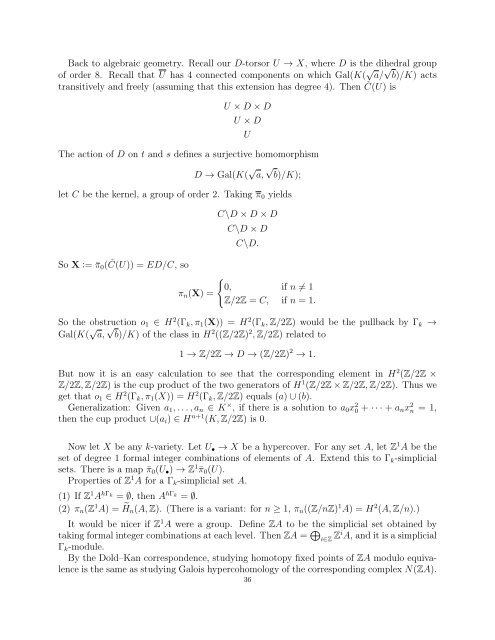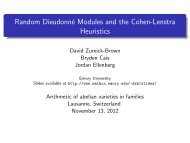alternative lecture notes - Rational points and algebraic cycles
alternative lecture notes - Rational points and algebraic cycles
alternative lecture notes - Rational points and algebraic cycles
Create successful ePaper yourself
Turn your PDF publications into a flip-book with our unique Google optimized e-Paper software.
Back to <strong>algebraic</strong> geometry. Recall our D-torsor U → X, where D is the dihedral group<br />
of order 8. Recall that U has 4 connected components on which Gal(K( √ a/ √ b)/K) acts<br />
transitively <strong>and</strong> freely (assuming that this extension has degree 4). Then Č(U) is<br />
U × D × D<br />
U × D<br />
The action of D on t <strong>and</strong> s defines a surjective homomorphism<br />
U<br />
D → Gal(K( √ a, √ b)/K);<br />
let C be the kernel, a group of order 2. Taking π 0 yields<br />
So X := ¯π 0 (Č(U)) = ED/C, so<br />
π n (X) =<br />
C\D × D × D<br />
C\D × D<br />
C\D.<br />
{<br />
0, if n ≠ 1<br />
Z/2Z = C, if n = 1.<br />
So the obstruction o 1 ∈ H 2 (Γ k , π 1 (X)) = H 2 (Γ k , Z/2Z) would be the pullback by Γ k<br />
Gal(K( √ a, √ b)/K) of the class in H 2 ((Z/2Z) 2 , Z/2Z) related to<br />
→<br />
1 → Z/2Z → D → (Z/2Z) 2 → 1.<br />
But now it is an easy calculation to see that the corresponding element in H 2 (Z/2Z ×<br />
Z/2Z, Z/2Z) is the cup product of the two generators of H 1 (Z/2Z × Z/2Z, Z/2Z). Thus we<br />
get that o 1 ∈ H 2 (Γ k , π 1 (X)) = H 2 (Γ k , Z/2Z) equals (a) ∪ (b).<br />
Generalization: Given a 1 , . . . , a n ∈ K × , if there is a solution to a 0 x 2 0 + · · · + a n x 2 n = 1,<br />
then the cup product ∪(a i ) ∈ H n+1 (K, Z/2Z) is 0.<br />
Now let X be any k-variety. Let U • → X be a hypercover. For any set A, let Z 1 A be the<br />
set of degree 1 formal integer combinations of elements of A. Extend this to Γ k -simplicial<br />
sets. There is a map ¯π 0 (U • ) → Z 1¯π 0 (U).<br />
Properties of Z 1 A for a Γ k -simplicial set A.<br />
(1) If Z 1 A hΓ k = ∅, then A<br />
hΓ k = ∅.<br />
(2) π n (Z 1 A) = ˜H n (A, Z). (There is a variant: for n ≥ 1, π n ((Z/nZ) 1 A) = H 2 (A, Z/n).)<br />
It would be nicer if Z 1 A were a group. Define ZA to be the simplicial set obtained by<br />
taking formal integer combinations at each level. Then ZA = ⊕ i∈Z Zi A, <strong>and</strong> it is a simplicial<br />
Γ k -module.<br />
By the Dold–Kan correspondence, studying homotopy fixed <strong>points</strong> of ZA modulo equivalence<br />
is the same as studying Galois hypercohomology of the corresponding complex N(ZA).<br />
36



